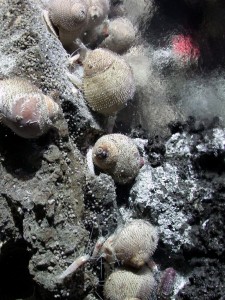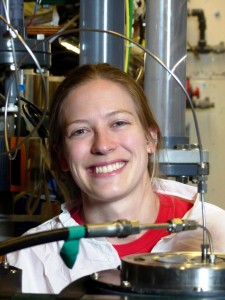10 April 2016
Inside the Box: Bringing Vent Life to the Surface
Posted by larryohanlon

One of the hydrothermal vent sea snails (Alviniconcha hessleri) that will be collected and kept in the high pressure aquaria. Credit: Charles Fisher and WHOI
Deep in the ocean, far removed from the sun, there is a wealth of biological diversity that exists at hydrothermal vents. As mentioned in Peter Girguis’s blog post, the animals that live in these habitats make a living through symbioses with microbes that live within their tissues. These microbes have unique metabolisms that enable them to generate energy from chemicals originating from within the earth.

Jennifer Delaney (left) and Jessica Panzarino (right) setting up the pressure van: connecting intricate electrical, sea water, pressure, and gas systems. Credit: Cherisse Du Preez
Even for experienced scientists, it can be an otherworldly sight, and studying these communities often proves as daunting as studying outer space. While advances in submersible technology allow us to visit these environments and collect samples, it is difficult to conduct experiments at the seafloor. The hydrothermal vent environment is extreme by human standards. Pressures at the sites we will be visiting during this cruise are around 240 atmospheres- this is equivalent to balancing a pickup truck on your big toe! The water expelled from these vents is hot and enriched in metals and sulfur-containing compounds, which—upon contact with cold seawater—precipitate out to form large chimney-like structures. Needless to say, even though these environments are present on Earth, this is a world much different than our own!

The pressure van is a custom-built mobile laboratory—housed in a 20-ft shipping container—which contains the infrastructure needed to keep deep-sea animals alive onboard the R/V Falkor. Jessica Panzarino (left) and Jennifer Delaney (right; blog author) will both work in the pressure van with live vent animals. Credit: Cherisse Du Preez
Imagine if we replicate this foreign world onboard the ship! That is exactly what we intend to do aboard the R/V Falkor using our custom-built mobile laboratory. Known as the “pressure van,” this laboratory—which is housed in a 20-ft shipping container—contains the infrastructure needed to keep deep-sea animals alive onboard a research vessel. The lab is capable of running eight flow-through aquaria, but these aren’t your typical aquaria: each vessel is made of titanium, designed to withstand deep-sea pressures, and the seawater feeding each vessel is bubbled with different gases to replicate the chemical composition of a hydrothermal vent environment. The pressure van is also refrigerated to mimic temperatures just outside of the venting areas.

Jennifer Delaney, with one of the titanium aquaria—which will mimic the extreme environment of a hydrothermal vent. Credit: Cherisse Du Preez
The pressure van is an incredible tool, because it allows us to vary the conditions experienced by (live!) animals in the vessels and then evaluate their response. This can be done using a flow-through method, wherein we measure specific chemicals in the seawater flowing into and out of the vessels. The difference between the two—along with the flow rate—is used to calculate metabolic rates for the animals and symbionts inside the vessel. We can also perform what are known as batch experiments, where we provide the animal with a set amount of chemical “food,” incubate them at pressure for a set amount of time, and then use various methods to determine how much food was consumed, as well as what metabolic pathways were used.
Setting up the pressure van has been no easy task. Once everything was unpacked, we got to work on connecting the electrical system to the ship (so we can power our high pressure pumps) and doing lots of plumbing. There were seawater lines to run, gas lines to run, and leaks to fix. Now, we’re almost up and running and ready for the first animal collection from the deep sea hydrothermal vents.
Be sure to check back for blog posts by Roxanne Beinart, who will be evaluating how the chemical environment influences the relationship between host and symbiont, and Jessica Panzarino, who will be investigating the possible effects of deep sea mining on vent animals.
Jenny Delaney is the lab manager for Dr. Peter Girguis at Harvard University. This post originally appeared on the Schmidt Ocean Institute blog.


 GeoSpace is a blog on Earth and space science, managed by AGU’s Public Information staff. The blog features posts by AGU writers and guest contributors on all sorts of relevant science topics, but with a focus on new research and geo and space sciences-related stories that are currently in the news.
GeoSpace is a blog on Earth and space science, managed by AGU’s Public Information staff. The blog features posts by AGU writers and guest contributors on all sorts of relevant science topics, but with a focus on new research and geo and space sciences-related stories that are currently in the news.